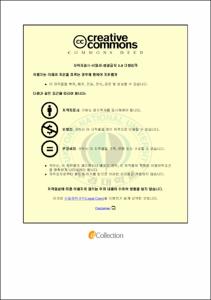웨이트트레이닝 시 운동 강도의 차이가 비만 중년 여성의 근 손상지표와 노화 관련호르몬 및 신체조성에 미치는 영향
- Alternative Title
- The Effect of Workout Intensity Level for Muscle Damaged Index, Aging Hormone, Body Composition of Obese-Middle Aged Women
- Abstract
- The Effect of Workout Intensity Level for Muscle Damaged
Index, Aging Hormone, Body Composition of Obese-Middle Aged Women
Byung-Ho Jang
Department of Physical Education
The Graduate School
Pukyong National University
Directed by Professor Koun-Soo Shin, Ph. D
Abstract
The purpose of his study is for middle-aged women to classify workout level into 3 groups(50% level, 60% level, 70% level during 12 weeks and to figure out the appropriate workout level by ascertaining the effect of body composition, muscle damaged index and aging hormone.
Methods: The subjects for this study are middle-aged women having over 30% body fat, and assigned into 3 groups on the basis of workout intensity(10persons of 50% intensity, 10persons of 60% intensity, 70persons of 50% intensity).
it was analyzed for data processing by doing two way anova of repetition method and established the level of significance around p< .05 on SPSS 18.0 Program after study.
Results: CK(muscle damaged index)was increased significantly from 70% group and among the groups, 70% group was extremely increased than 50, 60% group.
LDH was increased significantly from 60% and 70% group and among the groups, 70% group was extremely increased than 50% group.
second, melatonin(aging related hormone) was increased significantly from 70% there's no difference among the groups.
DHEA-S was increased significantly from 70% group, among the groups, 70% group was extremely increased than 60% and 70% group.
GH was increased significantly from 70% group, among the groups, 70% group was extremely increased than 60% and 70% group.
third, weight(body composition) was decreased for all, and there's none of dramatical difference.
Body Fat was decreased significantly from 50% group, among the groups, 50% group was extremely increased than 60% and 70% group.
amount of muscle was increased significantly from 70% group, among the groups, there's no difference among the groups.
Conclusion: muscle damaged index was effectively changed in low exercise intensity, but, aging related hormone was effectively changed in high exercise intensity, especially, DHEA-S and GH was significantly increased than 50%, 60%.
Body Composition wasn't changed in weight but, low exercise intensity is appropriate way in order to lose body fat and to make the result into being generalized, more various exercise intensity should be required.
Key words: muscle damaged index, aging hormone, body composition, obese-middle aged women.
- Issued Date
- 2014
- Awarded Date
- 2014. 2
- Type
- Dissertation
- Publisher
- 부경대학교
- Alternative Author(s)
- Byung-Ho Jang
- Affiliation
- 대학원
- Department
- 대학원 체육학과
- Advisor
- 신군수
- Table Of Contents
- Ⅰ. 서 론 1
1. 연구의 필요성 1
2. 연구의 목적 4
3. 연구의 문제 4
4. 용어정리 5
5. 연구의 제한점 6
Ⅱ. 이론적 배경 7
1. 웨이트트레이닝의 특징 7
2. 웨이트트레이닝과 근 손상지표 8
3. 웨이트트레이닝과 노화관련 호르몬 9
4. 웨이트트레이닝과 신체조성 11
Ⅲ. 연구 방법 12
1. 연구대상 12
2. 측정도구 12
3. 측정방법 및 항목 13
4. 실험계획 및 방법 15
5. 자료처리 18
Ⅳ. 연구 결과 19
1. 신체조성 19
2. 근 손상지표 25
3. 노화관련 호르몬 29
Ⅴ. 논 의 35
1. 근 손상지표 35
2. 노화관련 호르몬 37
3. 신체조성 41
Ⅵ. 결 론 43
1. 근 손상지표 43
2. 노화관련 호르몬 43
3. 신체조성 44
참고문헌 45
- Degree
- Doctor
- Files in This Item:
-
-
Download
 웨이트트레이닝 시 운동 강도의 차이가 비만 중년 여성의 근 손상지표와 노화 관련호르몬 및 신체조성에 미치는 영향.pdf
기타 데이터 / 1.19 MB / Adobe PDF
웨이트트레이닝 시 운동 강도의 차이가 비만 중년 여성의 근 손상지표와 노화 관련호르몬 및 신체조성에 미치는 영향.pdf
기타 데이터 / 1.19 MB / Adobe PDF
-
Items in Repository are protected by copyright, with all rights reserved, unless otherwise indicated.